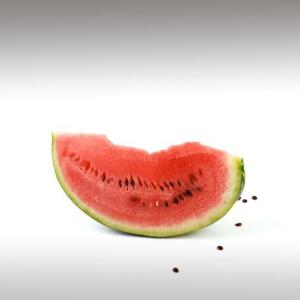
WATERMELON SEED OIL (CITRULLUS VULGARIS) - BASE OILS

BASE / GENERAL DATA
Information submited: August 1, 2014 Modified: May 10, 2018 By: OperaDreamhouse
Melons are one of the prominent fruits grows and cultivated in Central Asia. Country like Egypt and Palestine extensively farm water melons. Basically Watermelons are originated from East Indies and tropical parts of Africa.
Watermelon tree is pretty tall and the fruits may weigh up to 30 pounds. The best thing about the Watermelon fruit is that it supplies food and water both at a time. Its juice pulp is very tasty and acts as the best substitute of natural drinks and food in these dry conditions.
Watermelon tree is pretty tall and the fruits may weigh up to 30 pounds. The best thing about the Watermelon fruit is that it supplies food and water both at a time. Its juice pulp is very tasty and acts as the best substitute of natural drinks and food in these dry conditions.
The Watermelon fruit varies in shape and color.
The seeds are black-redish in the pulp. The pulp is again reddish filled
with juice.
Watermelon is fruit of dry states and that is why mostly and naturally grows in these areas. Kalahari Deserts, the banks of Nile are some of the best locations to get the Watermelon.
Watermelon seed oil is extracted by pressing from the seeds of the Citrullus Vulgaris. It is particularly common in West Africa, where it is also called ootanga oil or Kalahari oil.
Watermelon is fruit of dry states and that is why mostly and naturally grows in these areas. Kalahari Deserts, the banks of Nile are some of the best locations to get the Watermelon.
Watermelon seed oil is extracted by pressing from the seeds of the Citrullus Vulgaris. It is particularly common in West Africa, where it is also called ootanga oil or Kalahari oil.
Watermelons probably originated almost 5,000 years ago in the Kalahari Desert of Africa where botanists have found its wild ancestors still growing. Watermelons migrated north through Egypt, and during the Roman era they were cultivated and prized.
Traditionally, the seeds are extracted from the seed casing, and dried in the sun. Once dried, the seeds are pressed to extract the oil. The high content of omega acidsand linoleic acid within the oil assist in the removal of excess sebum within the skin.
Watermelon seed oil contains high amounts of unsaturated fatty acids with linoleic and oleic acids as the major acids.
The major chemical constituents of this essential oil include: linoleic acid, oleic acid, Thiamin, riboflavin, niacin, Folic Acid, Vitamin B6, B12, Calcium, Iron, Magnesiuk, Potassium, Phosphorous, sodium, Zinc, copper.
Traditionally, the seeds are extracted from the seed casing, and dried in the sun. Once dried, the seeds are pressed to extract the oil. The high content of omega acidsand linoleic acid within the oil assist in the removal of excess sebum within the skin.
Watermelon seed oil contains high amounts of unsaturated fatty acids with linoleic and oleic acids as the major acids.
The major chemical constituents of this essential oil include: linoleic acid, oleic acid, Thiamin, riboflavin, niacin, Folic Acid, Vitamin B6, B12, Calcium, Iron, Magnesiuk, Potassium, Phosphorous, sodium, Zinc, copper.

SPIRITUAL PRACTISES DATA

MEDICINE / HEALTH DATA

BEAUTY / COSMETICS DATA

FOOD / COOKING DATA
COMMENTS
No comments.


